If you were looking for a city built to be a caricature of a “Chinese” city, you wouldn’t have to look far, at least not if you were in Pingyao, a world heritage UNESCO city of nearly 50,000 people in Shanxi province. Unlike the similarly-positioned Lijiang, in Yunnan, far from here, which had to be partially reconstructed after an earthquake, Pingyao, for all practical purposes, looks rather like the city it has been since 1370, when the Ming moved it a few kilometers and enclosed the city in a stately wall that still surrounds the “ancient” city.

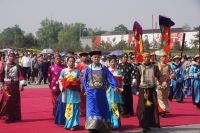 It has what you’d need to make it into a tourist destination–quaint Ming and Qing dynasty houses easily turned into ambient guest houses and restaurants and small shops.
It has what you’d need to make it into a tourist destination–quaint Ming and Qing dynasty houses easily turned into ambient guest houses and restaurants and small shops.
Our day began with a made-for-tourist celebration that consisted of young ladies on parade dressed in Qing costumes, imitating women with bound feet (some emperor liked it, so for centuries rich women broke the toes of their daughters to make them more attractive—only peasant women had regular-sized feet). The practice was not banned until the 20th century. The ladies were followed by jugglers, and the festivities culminated in a processional for the governor and his entourage.
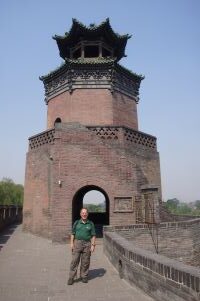
We then walked along the wall, originally built in 1372, and relatively intact  since then. It is about 6 miles long, but nowhere near as wide as the one in Xi’an. Most of the buildings in it are Ming/Qing, with some more recently built. There was one factory which the government evicted, and, as our guide noted, some of the land was given to developers for hotels, etc. Tourism, as I have been saying this whole trip, is the world’s biggest business, and China has some of the best infrastructure in the world for the business. It is a big revenue generator. Ticket prices for attractions have gone up greatly; the city tour package is over 30$ US. The government is now developing the tourist trade for domestic Chinese. I am one of the few non-backpacking Americans here, and there was a BIG crowd this weekend. The guides have taken to using megaphones, even for groups of 3 or 4, which makes some places impossibly noisy. One year I saw there were 15 million tourists!
since then. It is about 6 miles long, but nowhere near as wide as the one in Xi’an. Most of the buildings in it are Ming/Qing, with some more recently built. There was one factory which the government evicted, and, as our guide noted, some of the land was given to developers for hotels, etc. Tourism, as I have been saying this whole trip, is the world’s biggest business, and China has some of the best infrastructure in the world for the business. It is a big revenue generator. Ticket prices for attractions have gone up greatly; the city tour package is over 30$ US. The government is now developing the tourist trade for domestic Chinese. I am one of the few non-backpacking Americans here, and there was a BIG crowd this weekend. The guides have taken to using megaphones, even for groups of 3 or 4, which makes some places impossibly noisy. One year I saw there were 15 million tourists!
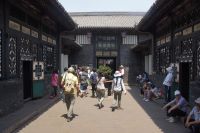
Among other visits in the city was one to China’s first bank, here in Pingyao in 1823. It handled bank transfers in over 20 cities, including Calcutta in India and Kowloon in Hong Kong, and lasted until the 1930s or so. It sounded like the Hanseatic League, with “internships” for young Chinese more interested in commerce (and wealth) than in government and Chinese classics. At one time, 90% of China’s banking service was done by Shanxi financiers, and much of that in Pingyao.
If you were looking for temples, this had some 4 star attractions. One, close to the city, and named for an episode in the life of the Buddha, had some statues that date back to the Song dynasty, or almost 1000 years ago. Some  of the statues retained their original colors, and the 1000 armed Guan Yin, the goddess of mercy (who in the process of moving from India to China became more feminine than masculine) is particularly striking.
of the statues retained their original colors, and the 1000 armed Guan Yin, the goddess of mercy (who in the process of moving from India to China became more feminine than masculine) is particularly striking.
In addition to the Buddhist temples, there was a city god temple, a Daoist celebration reconstructed during the reign of Qianlong, with a statue to the Guan Gong, my candidate to replace Tommy Titan. The Guan Gong is celebrated as the God of Wealth and the God of War, the former of which puts him pretty high in today’s Chinese pantheon (socialism with Daoist characteristics?).
former of which puts him pretty high in today’s Chinese pantheon (socialism with Daoist characteristics?).
Across from that, there is a Confucian temple that purports to be one of the best still extant in China (Confucius came in for a battering during the Cultural Revolution, as one of the “olds,” but I’ll have more to say about its revival before I leave China). There are some nice exhibits on the Confucian exams in the temple, which was one of the most serene places in the city.
There 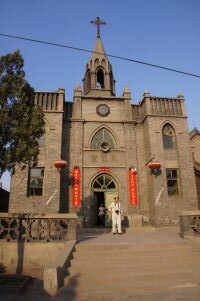
 are even two Christian churches from the early 20th century, one Catholic, one Protestant, which I understand are packed on Sundays.
are even two Christian churches from the early 20th century, one Catholic, one Protestant, which I understand are packed on Sundays.
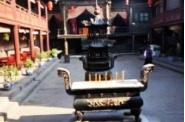
The other striking public building is the home of the governor, which is residence, administrative offices, and jail—all in one place. The striking thing was the jail and prison, partly because in criminal court cases, the plaintiff and defendants both knelt down in a specific spot before the judge, who could use torture (the tools of the trade were there, including knuckle busters) to extract confessions. A red-colored piece of wood signified death, and we saw, in the prison, the various forms of punishment, which ranged from public humiliation to beheading, to the “death by 1000 cuts,” which consisted of having your body wrapped in a fishnet, squeezed, and the skin that protruded sliced.
I said this is the ideal model for what foreigners (and Chinese) think is a model Ming/Qing city. I’ve been to others which have rebuilt areas like this—I think it was Kaifeng or Luoyang, former capitals. I know Xi’an has an area near the south wall that has a reconstructed “antique street” that is no more antique than the last four or five years. The difference is that Pingyao has an antique street that is an antique, and limits cars to the edges of the old walled city. It is a model—but it is an original, not a copy